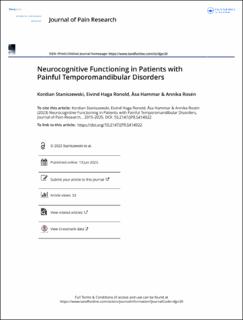| dc.description.abstract | Aim: To investigate psychosocial factors in painful TMD (pTMD) which could have consequences for mastering chronic pain.
Methods: Our study included 22 patients (20 women, 2 men) with pTMD, refractory to conservative treatment, and 19 healthy controls. The control group was matched for gender, age, and educational level, and IQ tested on the Wechsler Abbreviated Scale of Intelligence. Neurocognitive function was tested with the Color-Word Interference Test (CWIT). Pain intensity was reported according to the General Pain Intensity Questionnaire (GPI), using the Numeric Rating Scale (NRS). Self-perceived cognitive difficulties were reported by the Perceived Deficits Questionnaire-Depression 5-item (PDQ-5). Two measures of rumination were included: the Rumination-Reflection Questionnaire (RRQ) and the Ruminative Response Scale (RRS). The Montgomery Åsberg Depression Rating Scale Self-report (MADRS-S) was used to measure depressive symptoms, and the Oral Health Impact Profile-TMD (OHIP-TMD) to measure QoL related to oral health.
Results: There were no statistical differences in age (median pTMD: 55 years, median control: 53 years), educational level, and IQ between pTMD and controls. Median pain intensity in pTMD was NRS 8 at maximum and the median pain duration was 18 years. There were no significant differences in CWIT between pTMD and controls. Self-perceived cognitive function (PDQ) was significantly poorer in pTMD. Rumination scores from both measures, and the depression score from MADRS, were significantly higher in pTMD. The OHIP-TMD score revealed a significantly poorer QoL in pTMD.
Conclusion: The group of pTMD patients have self-perceived cognitive difficulties that may make it more difficult to master chronic pain and common everyday tasks. They reported significantly more self-perceived cognitive difficulties, higher rumination, more depressive symptoms, and lower QoL compared to healthy controls, suggesting that these psychosocial factors could be targeted in treatment and interventions. However, the tested neurocognitive performance was equivalent to the control group. | en_US |

